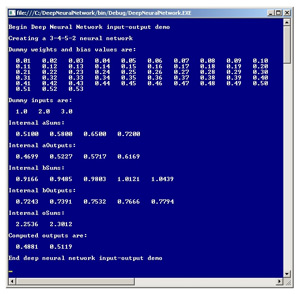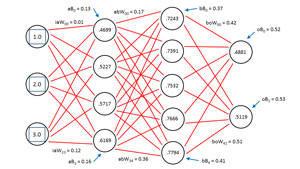Deep Neural Networks are the more computationally powerful cousins to regular neural networks. Learn exactly what DNNs are and why they are the hottest topic in machine learning research.
The term deep neural network can have several meanings, but one of the most common is to describe a neural network that has two or more layers of hidden processing neurons. This article explains how to create a deep neural network using C#. The best way to get a feel for what a deep neural network is and to see where this article is headed is to take a look at the demo program in Figure 1 and the associated diagram inFigure 2.
Both figures illustrate the input-output mechanism for a neural network that has three inputs, a first hidden layer ("A") with four neurons, a second hidden layer ("B") with five neurons and two outputs. "There are several different meanings for exactly what a deep neural network is, but one is just a neural network with two (or more) layers of hidden nodes." 3-4-5-2 neural network requires a total of (3 * 4) + 4 + (4 * 5) + 5 + (5 * 2) + 2 = 53 weights and bias values. In the demo, the weights and biases are set to dummy values of 0.01, 0.02, . . . , 0.53. The three inputs are arbitrarily set to 1.0, 2.0 and 3.0. Behind the scenes, the neural network uses the hyperbolic tangent activation function when computing the outputs of the two hidden layers, and the softmax activation function when computing the final output values. The two output values are 0.4881 and 0.5119.


Research in the field of deep neural networks is relatively new compared to classical statistical techniques. The so-called Cybenko theorem states, somewhat loosely, that a fully connected feed-forward neural network with a single hidden layer can approximate any continuous function. The point of using a neural network with two layers of hidden neurons rather than a single hidden layer is that a two-hidden-layer neural network can, in theory, solve certain problems that a single-hidden-layer network cannot. Additionally, a two-hidden-layer neural network can sometimes solve problems that would require a huge number of nodes in a single-hidden-layer network.
This article assumes you have a basic grasp of neural network concepts and terminology and at least intermediate-level programming skills. The demo is coded using C#, but you should be able to refactor the code to other languages such as JavaScript or Visual Basic .NET without too much difficulty. Most normal error checking has been omitted from the demo to keep the size of the code small and the main ideas as clear as possible.
The Input-Output Mechanism
The input-output mechanism for a deep neural network with two hidden layers is best explained by example. Take a look at Figure 2. Because of the complexity of the diagram, most of the weights and bias value labels have been omitted, but because the values are sequential -- from 0.01 through 0.53 -- you should be able to infer exactly what the unlabeled values are. Nodes, weights and biases are indexed (zero-based) from top to bottom. The first hidden layer is called layer A in the demo code and the second hidden layer is called layer B. For example, the top-most input node has index [0] and the bottom-most node in the second hidden layer has index [4].
In the diagram, label iaW00 means, "input to layer A weight from input node 0 to A node 0." Label aB0 means, "A layer bias value for A node 0." The output for layer-A node [0] is 0.4699 and is computed as follows (first, the sum of the node's inputs times associated with their weights is computed):
(1.0)(0.01) + (2.0)(0.05) + (3.0)(0.09) = 0.38
Next, the associated bias is added:
0.38 + 0.13 = 0.51
Then, the hyperbolic tangent function is applied to the sum to give the node's local output value:
tanh(0.51) = 0.4699
The three other values for the layer-A hidden nodes are computed in the same way, and are 0.5227, 0.5717 and 0.6169, as you can see in both Figure 1 and Figure 2. Notice that the demo treats bias values as separate constants, rather than the somewhat confusing and common alternative of treating bias values as special weights associated with dummy constant 1.0-value inputs.
The output for layer-B node [0] is 0.7243. The node's intermediate sum is:
(0.4699)(0.17) + (0.5227)(0.22) + (0.5717)(0.27) + (0.6169)(0.32) = 0.5466
The bias is added:
0.5466 + 0.37 = 0.9166
And the hyperbolic tangent is applied:
tanh(0.9166) = 0.7243
The same pattern is followed to compute the other layer-B hidden node values: 0.7391, 0.7532, 0.7666 and 0.7794. The values for final output nodes [0] and [1] are computed in a slightly different way because softmax activation is used to coerce the sum of the outputs to 1.0. Preliminary (before activation) output [0] is:
(0.7243)(0.42) + (0.7391)(0.44) + (0.7532)(0.46) + (0.7666)(0.48) + (0.7794)(0.50) + 0.52 = 2.2536
Similarly, preliminary output [1] is:
(0.7243)(0.43) + (0.7391)(0.45) + (0.7532)(0.47) + (0.7666)(0.49) + (0.7794)(0.51) + 0.53 = 2.3012 Applying softmax, final output [0] = exp(2.2536) / (exp(2.2536) + exp(2.3012)) = 0.4881. And final output [1] = exp(2.3012) / (exp(2.2536) + exp(2.3012)) = 0.5119
The two final output computations are illustrated using the math definition of softmax activation. The demo program uses a derivation of the definition to avoid arithmetic overflow.
Overall Program Structure
The overall structure of the demo program, with a few minor edits to save space, is presented in Listing 1. To create the demo, I launched Visual Studio and created a new project named DeepNeuralNetwork. The demo has no significant Microsoft .NET Framework version dependencies, so any relatively recent version of Visual Studio should work. After the template-generated code loaded into the editor, I removed all using statements except the one that references the top-level System namespace. In the Solution Explorer window I renamed the file Program.cs to the slightly more descriptive DeepNetProgram and Visual Studio automatically renamed class Program for me.
Listing 1: Overall Demo Program Structure
using System;
namespace DeepNeuralNetwork
{
class DeepNetProgram
{
static void Main(string[] args)
{
Console.WriteLine("Begin Deep Neural Network demo");
Console.WriteLine("Creating a 3-4-5-2 network");
int numInput = 3;
int numHiddenA = 4;
int numHiddenB = 5;
int numOutput = 2;
DeepNeuralNetwork dnn =
new DeepNeuralNetwork(numInput,
numHiddenA, numHiddenB, numOutput);
double[] weights = new double[] {
0.01, 0.02, 0.03, 0.04, 0.05, 0.06, 0.07, 0.08, 0.09, 0.10,
0.11, 0.12, 0.13, 0.14, 0.15, 0.16, 0.17, 0.18, 0.19, 0.20,
0.21, 0.22, 0.23, 0.24, 0.25, 0.26, 0.27, 0.28, 0.29, 0.30,
0.31, 0.32, 0.33, 0.34, 0.35, 0.36, 0.37, 0.38, 0.39, 0.40,
0.41, 0.42, 0.43, 0.44, 0.45, 0.46, 0.47, 0.48, 0.49, 0.50,
0.51, 0.52, 0.53 };
dnn.SetWeights(weights);
double[] xValues = new double[] { 1.0, 2.0, 3.0 };
Console.WriteLine("Dummy weights and bias values are:");
ShowVector(weights, 10, 2, true);
Console.WriteLine("Dummy inputs are:");
ShowVector(xValues, 3, 1, true);
double[] yValues = dnn.ComputeOutputs(xValues);
Console.WriteLine("Computed outputs are:");
ShowVector(yValues, 2, 4, true);
Console.WriteLine("End deep neural network demo");
Console.ReadLine();
}
static public void ShowVector(double[] vector, int valsPerRow,
int decimals, bool newLine)
{
for (int i = 0; i < vector.Length; ++i)
{
if (i % valsPerRow == 0) Console.WriteLine("");
Console.Write(vector[i].ToString("F" + decimals) + " ");
}
if (newLine == true) Console.WriteLine("");
}
} // Program
public class DeepNeuralNetwork { . . }
}
The program class consists of the Main entry point method and a ShowVector helper method. The deep neural network is encapsulated in a program-defined class named DeepNeuralNetwork. The Main method instantiates a 3-4-5-2 fully connected feed-forward neural network and assigns 53 dummy values for the network's weights and bias values using method SetWeights. After dummy inputs of 1.0, 2.0 and 3.0 are set up in array xValues, those inputs are fed to the network via method ComputeOutputs, which returns the outputs into array yValues. Notice that the demo illustrates only the deep neural network feed-forward mechanism, and doesn't perform any training.
The Deep Neural Network Class
The structure of the deep neural network class is presented in Listing 2. The network is hard-coded for two hidden layers. Neural networks with three or more hidden layers are rare, but can be easily created using the design pattern in this article. A challenge when working with deep neural networks is keeping the names of the many weights, biases, inputs and outputs straight. The input-to-layer-A weights are stored in matrix iaWeights, the layer-A-to-layer-B weights are stored in matrix abWeights, and the layer-B-to-output weights are stored in matrix boWeights.
Listing 2: Deep Neural Network Class Structure
public class DeepNeuralNetwork
{
private int numInput;
private int numHiddenA;
private int numHiddenB;
private int numOutput;
private double[] inputs;
private double[][] iaWeights;
private double[][] abWeights;
private double[][] boWeights;
private double[] aBiases;
private double[] bBiases;
private double[] oBiases;
private double[] aOutputs;
private double[] bOutputs;
private double[] outputs;
private static Random rnd;
public DeepNeuralNetwork(int numInput, int numHiddenA,
int numHiddenB, int numOutput) { . . }
private static double[][] MakeMatrix(int rows, int cols) { . . }
private void InitializeWeights() { . . }
public void SetWeights(double[] weights) { . . }
public double[] ComputeOutputs(double[] xValues) { . . }
private static double HyperTanFunction(double x) { . . }
private static double[] Softmax(double[] oSums) { . . }
}
from: https://visualstudiomagazine.com/articles/2014/06/01/deep-neural-networks.aspx
